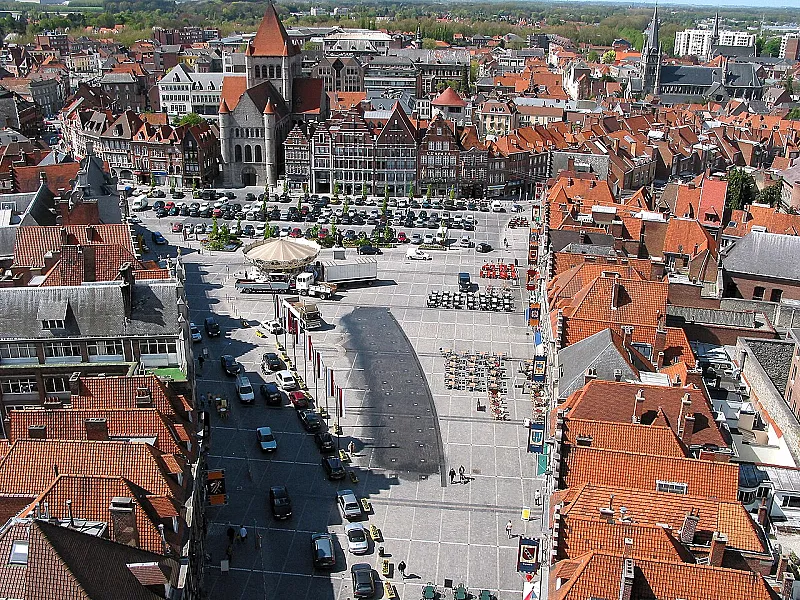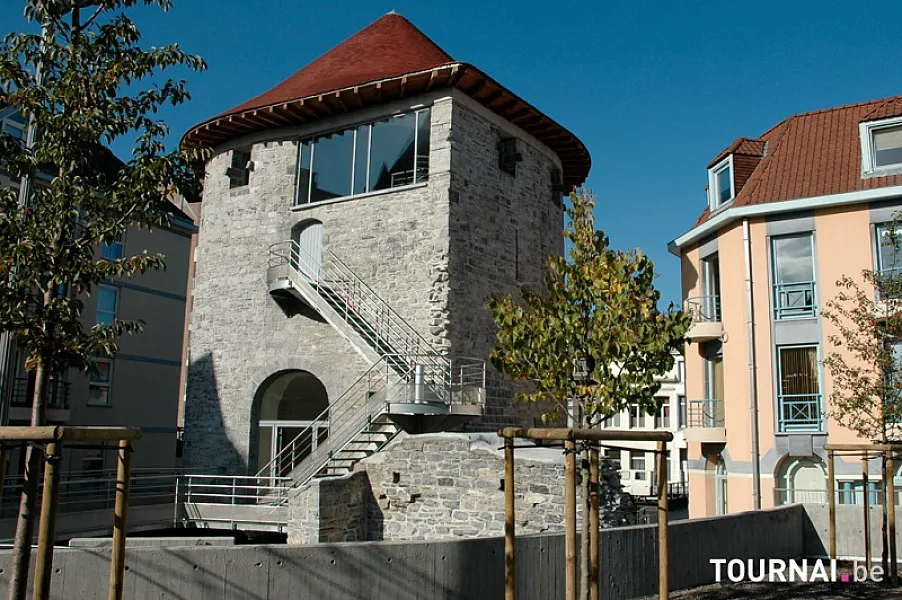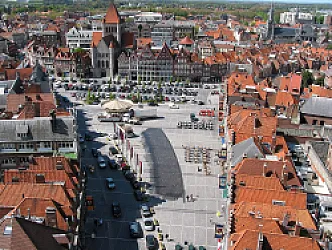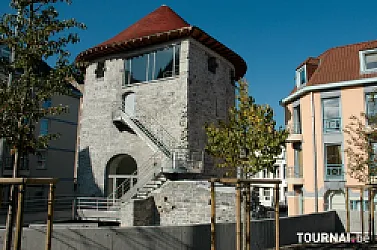Visit Tournai in 2 days
12 must-see POIs, optimized routes and anecdotes.
Loading map...
You will visit the most beautiful points of interest in Tournai
2 Days in Tournai — A Compact Love Letter to Belgium's Quiet Giant
Tournai stole my heart the moment I stepped onto its cobbled streets. The city feels like a secret passed between friends, full of layered history and the hush of church bells. Locals sometimes call it the "City of Five Bell Towers," and that sound still rings in my memory. Some people say it is overrated, but for me the intimacy and slow rhythms are the magic. I wandered here alone one rainy afternoon and left planning my return.
Why visit Tournai? Because it is more than a postcard. The city blends solemn medieval stone with warm cafés and surprising contemporary museums. You can stand beneath the soaring vaults of Notre-Dame Cathedral of Tournai and feel tiny, then stroll to the lively Grand-Place where local chatter mixes with the scent of fresh fries. Maison Tournaisienne reveals private lives from centuries past. Queen Astrid Park offers green calm and a view of the river. Expect soft bell tones, toasted bread aromas, and the rough feel of old bricks beneath your fingers. This is a place to look, listen, and slow down.
Planning can feel overwhelming. There is so much to see you could easily spend weeks exploring. If you are short on time, I get the frustration; I’ve rushed through cities before and regretted it. That’s why this compact plan exists. Below, I’ll show you exactly how to spend 2 days in Tournai without missing the soul of the place. It’s designed for first time in Tournai visitors who want a true taste of the city, not a checklist of sights.
Key tip: Arrive early to the cathedral and Grand-Place. Morning light makes the stone glow and the streets stay quiet. You’ll photograph better, hear the bells clearly, and enjoy a peaceful moment before tour groups arrive. This simple trick changes everything. Now let’s dive into the Tournai itinerary and discover what to see in Tournai over a perfect weekend.

Quick Mini Guide to Tournai
Where to stay:
- Choose the Old Town near Grand-Place for walking access to the Cathedral, City Hall and cafés.
- Riverside hotels by the Scheldt offer quieter evenings and scenic morning walks.
When to visit:
- Spring and early autumn — mild weather for climbing the cathedral towers and strolling Queen Astrid Park.
- Weekdays or early mornings to avoid coach-group peaks at Notre‑Dame Cathedral and the Belfry.
Things to do (2 days):
- Day 1: Notre‑Dame Cathedral of Tournai (note the five towers and UNESCO site), then Maison Tournaisienne for local interiors and history.
- Day 2: Tournai City Hall and Belfry on the Grand‑Place, relax in Queen Astrid Park; finish with a riverside café on the Scheldt.
- Try one interactive tour — The Alchemist TOURNAI or The Trophy of the Tribes TOURNAI — gamified walking routes (book ahead, ~1–2 hours).
Don't forget:
- Comfortable shoes for cobbled streets and narrow alleys.
- Check opening hours for Maison Tournaisienne and climb times for the Belfry; small museums close midday in low season.
Day 1 - Tournai
6 POIs to discoverDay 1 - Morning à Tournai
5 Points of interest - Duration : 4h15 - Distance : 1 km - Walking : 0h13
Maison Tournaisienne
- The Musée de Folklore et des Imaginaires, formerly Maison tournaisienne, has occupied a 17th century building since 1930. The museum recreates scenes of everyday life in the city and in the countryside, highlighting the folklore and atmosphere of bygone eras. Visitors can discover artisans at work, chapel choirs, carnival costumes and even a cabaret in the various rooms of the museum. The exhibits include showcases with traditional objects that reveal the habits and customs of previous centuries, and occupy more than 1,000 m2.

Tournai City Hall
- The Tournai Town Hall is located on pleasant grounds.
- It occupies part of the former Benedictine abbey of Saint-Martin.
- Built in the 11th century, the monastery was suppressed in 1797.
- Rebuilt in 1763 under the abbatial of Robert Delzenne.
- A fire devastated the interior of the building in 1940, but the neoclassical facades survived.
- From the former abbey, an impressive Romanesque crypt and part of the Gothic cloister remain.
- The Saint-Martin monastery, located in the center of the city, is the place of worship of the Benedictines.

Notre-Dame Cathedral of Tournai
- The cathedral of Notre-Dame de Tournai is the only religious building in Belgium built specifically as a cathedral.
- Construction of the cathedral began in the 12th century, with a Scaldian Gothic style, harmoniously combining Romanesque and Gothic styles.
- Three cathedrals have been erected since the 5th century, with successive restorations and extensions.
- It has impressive dimensions, with a total length of 134 meters and five Romanesque towers 83 meters high.
- The five Romanesque towers rise above the cathedral, already heralding Gothic art.
- The Romanesque nave, the oldest part, is characterized by its rich sculpted decoration and harmonious proportions.
- The transept, although less harmonious than the nave, impresses with its proportions, and the Gothic choir is gigantic, with a total length of 58 meters.
- The cathedral has a rich sculpted decoration and remarkable architectural elements, which testify to its historical and artistic importance.

Grand-Place
- Tournai's Grand-Place is the center of activity of the Belgian city, with a triangular shape resulting from ancient roadways.
- Originally a cemetery, it became a market place during Carolingian times, marking the center of communal life after the erection of a bell tower in 1187.
- Largely destroyed by German bombing in 1940, the Grand-Place was rebuilt while retaining historical elements.
- La Halle aux draps, built in the 12th century, is a landmark building where cloth and cloth markets were held.
- In the center of the Grand-Place stands a bronze statue of the Princess of Epinoy, Christine de Lalaing, in honor of her supposed defense of the city during the siege of 1581.
- The Grand-Place remains a lively place for trade, fairs and events, with a varied gastronomic atmosphere typical of the region.The Grand-Place remains a lively place for trade, fairs and events.

Fort Rouge
- The Red Fort was a defensive tower of the first city wall, but discoveries suggest later remodeling.
- Philip II Augustus pushed for the construction of the Red Fort in the late 12th century.
- Archaeological excavations have revealed older structures, confirming the integration of the Red Fort into the early city wall.
- After years of neglect, the city of Tournai has undertaken the restoration of the Red Fort and its surroundings.
- It now hosts temporary exhibitions on its two restored levels The renovated site, now called "Islet of the XII Caesars," includes the Red Fort and green spaces open to the public.
Day 1 - Afternoon à Tournai
1 Points of interest - Duration : 0h45 - Distance : 0 km - Walking : 0h00Queen Astrid Park
- The Place de la Reine was created in 1872 on the site of the fortified works of the Ancien Régime.
- It replaced the ramparts, moats and bastions that defended the gate of the "Seven Springs".
- The park comprises mainly an expanse of water, close to the level of the Scheldt.
- There is a black walnut tree, the largest in the country, as well as bald cypresses and purple beeches among other varieties of trees.
- As for flowers, mahonias, hydrangeas and hibiscus have been planted, fulfilling the wishes of the inhabitants of Tournai. There is also part of artist Richard Owczarek's sundial, 80 cm wide and more than a meter long.
- This sundial is special: Its table forms a 50-degree angle with the horizontal plane, equivalent to a horizontal sundial at the equator.
- The hour lines are parallel accordingly.The style, unfortunately removed, was also parallel to the dial table.⏰ It is designed to indicate solar time from 7 am to 5 pm.
Day 2 - Tournai
6 POIs to discoverDay 2 - Morning à Tournai
5 Points of interest - Duration : 4h15 - Distance : 1 km - Walking : 0h13
Maison Tournaisienne
- The Musée de Folklore et des Imaginaires, formerly Maison tournaisienne, has occupied a 17th century building since 1930. The museum recreates scenes of everyday life in the city and in the countryside, highlighting the folklore and atmosphere of bygone eras. Visitors can discover artisans at work, chapel choirs, carnival costumes and even a cabaret in the various rooms of the museum. The exhibits include showcases with traditional objects that reveal the habits and customs of previous centuries, and occupy more than 1,000 m2.

Tournai City Hall
- The Tournai Town Hall is located on pleasant grounds.
- It occupies part of the former Benedictine abbey of Saint-Martin.
- Built in the 11th century, the monastery was suppressed in 1797.
- Rebuilt in 1763 under the abbatial of Robert Delzenne.
- A fire devastated the interior of the building in 1940, but the neoclassical facades survived.
- From the former abbey, an impressive Romanesque crypt and part of the Gothic cloister remain.
- The Saint-Martin monastery, located in the center of the city, is the place of worship of the Benedictines.

Notre-Dame Cathedral of Tournai
- The cathedral of Notre-Dame de Tournai is the only religious building in Belgium built specifically as a cathedral.
- Construction of the cathedral began in the 12th century, with a Scaldian Gothic style, harmoniously combining Romanesque and Gothic styles.
- Three cathedrals have been erected since the 5th century, with successive restorations and extensions.
- It has impressive dimensions, with a total length of 134 meters and five Romanesque towers 83 meters high.
- The five Romanesque towers rise above the cathedral, already heralding Gothic art.
- The Romanesque nave, the oldest part, is characterized by its rich sculpted decoration and harmonious proportions.
- The transept, although less harmonious than the nave, impresses with its proportions, and the Gothic choir is gigantic, with a total length of 58 meters.
- The cathedral has a rich sculpted decoration and remarkable architectural elements, which testify to its historical and artistic importance.

Grand-Place
- Tournai's Grand-Place is the center of activity of the Belgian city, with a triangular shape resulting from ancient roadways.
- Originally a cemetery, it became a market place during Carolingian times, marking the center of communal life after the erection of a bell tower in 1187.
- Largely destroyed by German bombing in 1940, the Grand-Place was rebuilt while retaining historical elements.
- La Halle aux draps, built in the 12th century, is a landmark building where cloth and cloth markets were held.
- In the center of the Grand-Place stands a bronze statue of the Princess of Epinoy, Christine de Lalaing, in honor of her supposed defense of the city during the siege of 1581.
- The Grand-Place remains a lively place for trade, fairs and events, with a varied gastronomic atmosphere typical of the region.The Grand-Place remains a lively place for trade, fairs and events.

Fort Rouge
- The Red Fort was a defensive tower of the first city wall, but discoveries suggest later remodeling.
- Philip II Augustus pushed for the construction of the Red Fort in the late 12th century.
- Archaeological excavations have revealed older structures, confirming the integration of the Red Fort into the early city wall.
- After years of neglect, the city of Tournai has undertaken the restoration of the Red Fort and its surroundings.
- It now hosts temporary exhibitions on its two restored levels The renovated site, now called "Islet of the XII Caesars," includes the Red Fort and green spaces open to the public.
Day 2 - Afternoon à Tournai
1 Points of interest - Duration : 0h45 - Distance : 0 km - Walking : 0h00Queen Astrid Park
- The Place de la Reine was created in 1872 on the site of the fortified works of the Ancien Régime.
- It replaced the ramparts, moats and bastions that defended the gate of the "Seven Springs".
- The park comprises mainly an expanse of water, close to the level of the Scheldt.
- There is a black walnut tree, the largest in the country, as well as bald cypresses and purple beeches among other varieties of trees.
- As for flowers, mahonias, hydrangeas and hibiscus have been planted, fulfilling the wishes of the inhabitants of Tournai. There is also part of artist Richard Owczarek's sundial, 80 cm wide and more than a meter long.
- This sundial is special: Its table forms a 50-degree angle with the horizontal plane, equivalent to a horizontal sundial at the equator.
- The hour lines are parallel accordingly.The style, unfortunately removed, was also parallel to the dial table.⏰ It is designed to indicate solar time from 7 am to 5 pm.
Where to Stay in Tournai
For a short, relaxed two-day visit to Tournai, location matters more than flashy facilities. The city is compact and largely built around its medieval heart, so choosing a base close to the sights saves time and reduces stress. Staying near the historic center means you can pop back to your room between museum visits, linger over a long lunch without rushing, and enjoy the atmosphere of the old streets after the daytime crowds have thinned.
Tournai is organized around a few easy-to-understand anchors: the elevated cathedral precinct around the Notre-Dame, the lively market area where the Grand-Place and Tournai City Hall sit, the intimate lanes that host the Maison Tournaisienne, and the greener belt toward Queen Astrid Park and the train approaches. The river adds a pleasant edge to walks but all the main attractions are within a short stroll of one another, which makes the city ideal for exploring on foot.
If you want to be in the thick of it, pick accommodation within a few minutes’ walk of the Cathedral or the Grand-Place: you’ll be able to visit Notre-Dame Cathedral of Tournai early in the morning or late in the day when light and quiet are at their best, and the museum circuit (including Maison Tournaisienne) is just around the corner. For a quieter stay with easy rail links, consider the area toward Queen Astrid Park and the train station, where green space and convenience meet — still close enough to return for a short rest between activities.
Practical transport tips: most visitors find everything reachable on foot — many of the attractions are within comfortable walking distance of each other — but Tournai also has a simple local bus network and regular regional trains to Brussels and Lille if you’re planning day trips. If you’re arriving by car, expect limited central parking; choosing a place near public transport or a hotel that offers a parking option can remove that hassle.
Finally, choose accommodation that matches how you like to travel: a cosy B&B or an apartment gives you flexibility and local charm, while smaller hotels often help with luggage and local tips. In historic buildings, check for practical features like lift access and a quiet room facing a courtyard. Book a little ahead for weekends or event dates, and otherwise relax — with a central, well-located base you’ll cover Tournai’s highlights easily and enjoy a calm, memorable stay.
Getting Around Tournai
Tournai is wonderfully compact, and public transport here feels friendly rather than intimidating — perfect for first-time visitors. The town center, with the Grand-Place, Notre-Dame Cathedral and the belfry within easy reach, is a pleasure to explore on foot, but when you need to stretch farther you'll find a simple network of regional trains and local buses. The main operators are SNCB for trains and TEC for buses, and both serve clear stops around the city, so you never feel lost even if this is your first trip. I love how the city blends walking routes with short, reliable rides — it makes sightseeing relaxed and efficient 🚇.
A practical tip about fares: you can usually buy single tickets from a ticket machine at the station, from drivers on buses (exact change sometimes required), or via the official apps for SNCB and TEC. If you plan a few journeys in a day, consider a day pass or a short-term regional pass — they simplify hopping on and off without thinking about every fare. For repeat visitors or longer stays, a reloadable card is handy; otherwise the apps and machines cover most needs easily 🎫.
Use Google Maps for real-time directions and to compare walking versus bus or train times. I rely on it to tell me whether it’s a pleasant 12-minute stroll between sights or better to catch the next bus. Maps will also show which bus stop to use and estimated arrivals, and when combined with the SNCB app for trains you can see platform information in advance. Downloading offline maps for a day or two gives extra peace of mind if your data is patchy.
If you want to save money, prioritise walking for short hops — many of Tournai’s highlights are clustered and strolling lets you discover hidden streets and cafés. Buy round-trip train tickets or multi-ride bus passes when available, and check for any regional discounts (student, senior, or group rates). Timing off-peak travel can also lower costs and keep crowded buses at bay; small changes in timing add up to big comfort and savings over a few days 💡.
I remember arriving at Tournai station with a suitcase and debating a bus versus a walk. We took a short TEC ride to the heart of town, then left our bags at the guesthouse and walked from the Maison Tournaisienne straight to the cathedral. It was only a ten-minute stroll to the Notre-Dame Cathedral, and that mix — one short bus, then walking between the sights — became our rhythm for the weekend. Once you try it, you’ll see how easy and charming getting around Tournai can be 🗺️.
What to Pack for Tournai
Tournai is delightfully compact but rich — cathedral spires, small museums, cobbled streets and quiet squares where you’ll linger longer than you planned. I’ve done weekend trips where I covered the town on foot for 9–10 hours a day and another when I relaxed with just a few short strolls; packing light but smart makes both days enjoyable. Below are the essentials I actually use and why each one mattered on my trips.
1. Comfortable walking shoes (e.g., Merrell Moab 2 or Ecco Soft 7): I once walked roughly 8 miles in a day around the cathedral, the belfry and across the old town — my feet would have been ruined without supportive shoes. Choose shoes with good arches and a grippy sole for cobbles; you’ll thank yourself after staircases and uneven pavements.
2. Cross-body bag (zippered, anti-theft): I prefer a small cross-body with an internal zip pocket — I wore mine while exploring the cathedral and market and felt secure when the streets got crowded. Tournai is generally safe, but tourist areas attract pickpockets; a bag you can keep in front is both comfortable and practical for a day out.
3. Weather-appropriate clothing (layers + lightweight rain jacket): Belgian weather flips quickly. On one trip I started with a T-shirt and ended the day in a waterproof layer after a sudden shower. Pack a thin fleece or sweater and a packable rain jacket — layers let you adapt when it’s cool in the morning, mild by midday and damp later.
4. Power adapter (Type E/European plug) and phone charger: Belgium uses Type E (230V). I forgot my adapter once and borrowed one from my B&B host — a hassle I won’t repeat. A small EU adapter lets you charge your phone and camera in the hotel and keeps you ready for maps and photos.
5. Power bank (10,000 mAh recommended): I was out for 10+ hours taking photos of the cathedral and using maps; my phone hit 15% by late afternoon until I used a 10,000 mAh power bank to get through the evening. Compact but powerful keeps navigation and ticket apps alive.
6. Optional: compact umbrella + reusable water bottle: On rainy days a tiny umbrella saved me from soggy maps; on sunny strolls a refillable bottle saved money and kept me refreshed while wandering between sites. Both are small, low-weight additions that paid off when I needed them.
Enjoy Your Trip to Tournai!
Two days in Tournai, packed with six must-see spots, give you a perfect snapshot of the city. From the charming Maison Tournaisienne to the ornate Tournai City Hall and the towering Notre-Dame Cathedral of Tournai, this itinerary moves through museums, historic fortifications and cultural landmarks — everything you need for a lively, well-rounded weekend.
Remember, this guide is a map, not a strict timetable: leave room for the unexpected. The real magic often happens in unplanned moments — getting delightfully lost in narrow streets, stumbling on small museums or a hidden chapel, or lingering for a spontaneous café stop. Allow extra time for a local market, a photo break, or a friendly chat with a shopkeeper. Don’t pressure yourself to see EVERYTHING; savor the pace and the surprises.
I hope you fall for Tournai’s warm corners and layered history. I’m excited for you to wander through the Maison Tournaisienne, stand before the cathedral’s stained glass, and make unforgettable memories. Embrace curiosity, follow what delights you, and let the city surprise you.
Want to explore in a playful way? Check out Coddy’s gamified tours — The Alchemist TOURNAI and The Trophy of the Tribes TOURNAI — for interactive challenges that turn your city walk into a small adventure. They’re fun and simple to follow.
Enjoy! Safe travels! Have fun! If you want, share your discoveries or ask a question — I’d love to hear about your Tournai stories.
Want more adventure?
Discover our urban escape games to transform your visit into an interactive adventure!
















